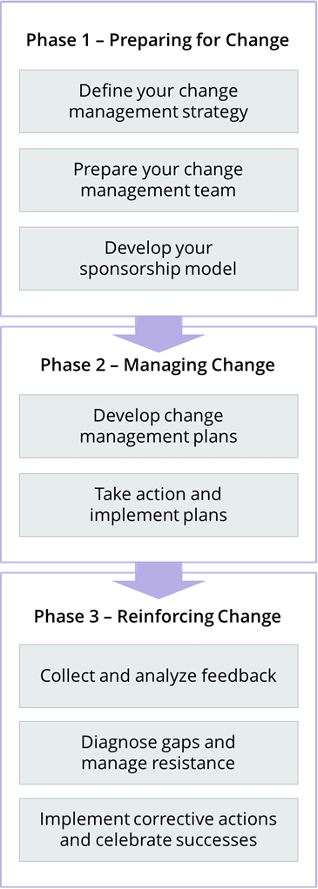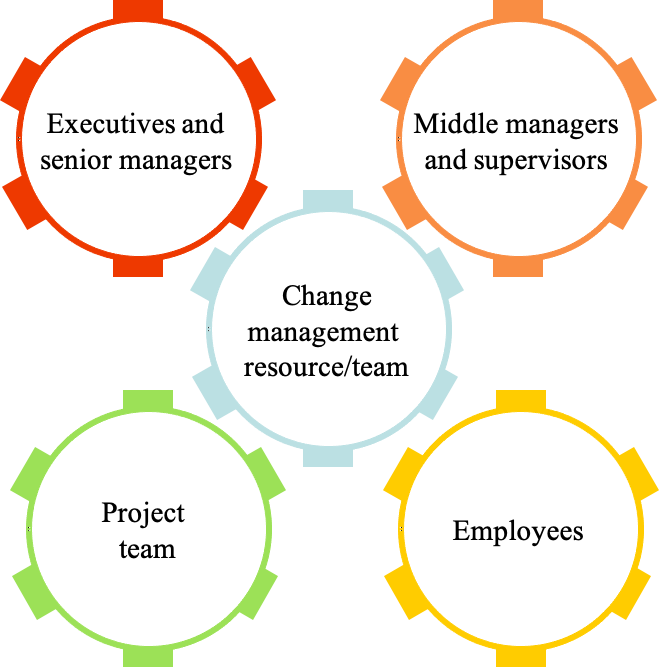The Art of Managing the People Side of Change

Change comes in all forms and sizes. There’s change that produces minor ripples throughout a manufacturing floor. And there’s change on a tsunami scale that completely alters the way employees view and perform their jobs.
How that change is managed varies greatly on who you are. If you’re a manager involved in planning and rolling out a new process, you might be excited about the potential for new efficiencies and growth. However, frontline workers might view it as one more thing to learn, the “flavor of the month,” or something that further complicates their work environment.
Organizations can’t change if their employees don’t change.
When we start talking about managing the people side of change, it’s critical to understand that everybody starts in a different place. Change can be scary. Individuals may worry about how a change will affect their job, coworkers, or livelihood. To achieve success, you must be patient and realistic. And you have to model positive change behaviors for employees to follow.
Change starts with your individual employees and how they will react to or adopt what you introduce. As you lead a change process, begin by putting yourself in their shoes. Ask yourself, what would this change mean to me? Is this something I can get on board with? What questions do I have?
If you can’t readily and competently answer those questions, it will be impossible to change your organization. It is only possible to lead change if you are comfortable moving forward. Again, I’ll stress this: your organization can’t change if your frontline employees don’t change.
If not executed properly, your new process, equipment, or software program could produce the opposite of your desired outcome, resulting in lower productivity, turnover of valued employees, and internal strife.
As you accept this reality, consider these steps to help you and your employees adopt change in whatever form you plan to introduce.

Plan with the Prosci Process
When I work with clients to introduce new software or a process, I encourage them to use the Prosci organization change management process. This is a three-phase structured process for managing the “people side” of change on a project or initiative. The approach is research-based, holistic, easy to apply, and scalable. The three phases include:
- Phase 1: Preparing for Change – to define your change management strategy, prepare your team and develop a sponsorship model.
- Phase 2: Managing Change – to develop and implement your change management plan.
- Phase 3: Reinforcing Change – to collect and analyze feedback, diagnose gaps, manage resistance, and implement corrective actions.
Build and Manage a Cohesive Message
At the beginning of your change process, develop messaging that proactively answers questions from all sides of your business. Why is this change necessary? How does it support your overall goals? What processes or procedures will it replace? What impact will it have on employees?
By proactively covering all angles, you can connect with multiple audiences and effectively manage the fear associated with your process. Your communication plan should match your rollout plan in areas such as timing, audiences, and next steps.
Know Your Audience and Their Communication Roles
Your communication plan should include multiple groups: your change management resource team, senior leadership, middle management, the project team, and employees. Their importance and roles look like this:
- The change management resource team or individual should be the center of your change universe, communicating with your broader audience. They’re the enablers of your program, serving as the conductor of your orchestra or director of your play.
- Senior leadership provides an active and visible sponsorship that can help build and sustain a coalition with peers and other managers to support the project. They will act as one of two preferred communicators about change. It’s critical that they be visible and engaged throughout the entire project. Their message will center around the business aspect of change, explaining how it helps your company achieve its overall goals and improve quality and customer satisfaction.
- Managers and supervisors (middle management) are preferred messengers, leveraging their knowledge and employee relationships. They are best positioned to help employees embrace, adopt and use your program.
- The project team (think IT or continuous improvement team) designs and develops the desired change and integrates it into plans and operations. This team helps develop the technical side of your program with responsibility for designing, developing, and delivering your program. They will constantly evaluate the process and inform you of any necessary changes.
- Employees will ultimately view changes by how they affect their day-to-day work, which impacts the success of your project and your ability to achieve your desired goals. They need to know the “why” behind your project and understand how it helps the company achieve its goals. They’ll also be your best source of information about any issues and general feedback.

Tailor Delivery Mechanisms
Once you’ve crafted the message, audiences, and communicators, decide how you will communicate your project. Much of this decision will depend on your audience. If messaging to the leadership team, an email might suffice. A smaller in-person meeting or video conference call might provide a better means for receiving feedback and questions. You might also take advantage of meetings with executive leadership, managers, and supervisors to provide project updates.
For frontline workers, a meeting before or after a shift or huddle talk is a great way to present the project, explain your overall goals, and answer questions. Posters, bulletin boards, and table tents in the breakroom can serve as an effective means to promote the upcoming change.
Eliminate Surprises
When timing your communications, ensure employees are notified well ahead of any potential changes. For example, if the change requires training, don’t let the classroom setting be the first time they hear about the project. Tease up the project weeks before implementing it, which means you must be aligned with the project team and communicate early and often.
Set the Stage for Rewards, Recognition, and Feedback
Create events that reward and recognize employees who embrace and help to move your change process forward. These events can also serve as opportunities to provide updates and seek feedback from the people they affect the most. Your frontline employees will serve as your best and most accurate barometer for the success of your rollout.
These steps can help you develop and roll out changes, whether it’s a new piece of equipment on the floor, a new technique, or a new product. Making that personal connection will help reduce anxiety levels and promote adoption. Our Training Strategy Consulting team frequently works with manufacturers to help roll out new programs and develop employee training to help make changes possible.
Contact us if you’d like to hear what we’re doing with other manufacturers or if you need help creating change with a people-first strategy.





